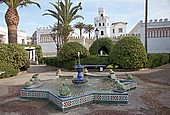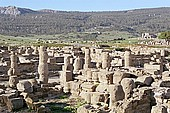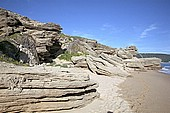The Atlantic Costa de la Luz stretches from Punta de Tarifa in the Straits of Gibraltar to the Portuguese border. Sandy, unspoilt beaches yet to succumb to the ugly mass tourism that has all but destroyed other areas, the main protection of the coast is its unkindness. Three civilisations after all, Roman, Moors and today motorised swimmers have struggled against that indomitable environment, yet still it remains a perfectly unspoiled and unkempt coastline, of fine sands and furious, unrelenting winds. From midday beaches are plagued by furious Tarifan wind that protect this coast from the ravages of tan-seeker tourists: lying by the sea in the afternoon is an experience akin to a sand-blasting.
Here we briefly explore some of the major locations.
Costa da Luz, Tarife
|
 |
Once a quiet village, Tarifa now ranks with the top three surfing resorts of the world, even in the winter surfers can be found on it's shores. In recent years Tarifas' shores are witnessing also the constant struggle of the Guardia Civil coastal helicopters and motorboats with the illegal immigrants, the 'wetbacks', escaping the plight of Africa. Above the town there is a cemetery where rows of nameless headstones mark the graves of unknown Africans that did not survive the crossing. The landscape is an astonishing spectacle: the mountains of Morocco rise during the day, the lights of Tangier shimmer across the water at night. From the
Castillo de Guzman there are the best views of Morocco coastline. Down the port with the hydrofoils leaving every day to Tangiers. There is a great appeal in wandering the crumbling ramparts of Tarifa's old
Moorish walls or narrow streets that surround the 15th century church of San
Mateo. The walk along the narrow causeway at the end of Punta Marroqui offers fine views of both sides of the bay.
Northwest lie long stretches of deserted beach of yellow sand heaven for the wind surfers. The wind that makes famous this spot blows every day of the year, coming from the Atlantic and squeezed between the coastal mountains of Africa and Spain takes speed and strength. The wind here is modelling the landscape a large dune of shifting sand is literally submerging the coastal pine wood at a speed that the sand has to be constantly removed, moreover all the hills behind the bay are literally covered and spoiled by modern ugly windmills that exploit the constant winds. So forceful and unforgiving, in fact, is the breeze that sweeps through the Tarife narrow streets, that it is said to have driven a number of the residents to clinical insanity.
 |
Tarife, Baelo Claudia
|
The Roman ruins of Baelo Claudia (Bolonia ) are a delightful background to a picturesque bay, its ruins are the remains of the ancient fishing and whaling community that once lived here. Baelo Claudia occupies one of the most impressive sites on the entire Spanish coast: the slow sandy curve of a four kilometre beach, the meadow-green valleys tumbling down from high rocky escarpments. Many of the Basilica's columns survive, as do parts of the forum, theatre, market and temples. The town was founded around the fishing and salt-preserving industry that sprang up at the water's edge.
 |
Costa da Luz, Cabo Trafalgar
|
Cabo de Trafalgar, where the famous battle of Trafalgar was fought on the 2lth Oct. 1805 when the British navy under the command of Admiral Nelson destroyed the unified French' Spanish armada.
Zahara de los Atunes still remain some feeling of the life relying mostly on fishing.
|
Related Pages
††-
††-
††-
|
|



